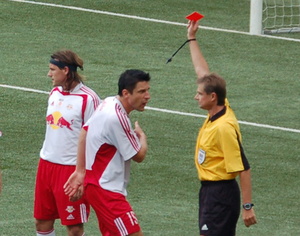
There are so many aspects of football that modern fans take for granted. Elsewhere on this site we’ve written about corner flags, the size of the football and even the layout of the design of a England and how it evolved from the plain field that was played on when the sport was in its infancy. Football has grown to become the biggest and most watched sport in the world, so we rarely think about the parts of the game that have developed over the years, let alone the ones that have been invented in their entirety.
It’s not uncommon for a modern-day fan of the game to see a goalkeeper panic when his defender passes it back to him, for example, knowing that he’s not allowed to pick the ball up for fear of giving away an indirect free-kick for being in violation of the back pass rule. Yet that law was only instigated in 1992. Those that watched football throughout the 1960s, 1970s and 1980s still find themselves wondering why the defence doesn’t kick the ball back to the goalkeeper to waste some time.
Of all the rules that have been introduced to football over the years, perhaps none have been as influential as the decision to issue players with yellow and red cards for infractions of the rules of the game. The backpass rule that we’ve just mentioned is widely considered to be one of the game’s most successful changes, but it has never had the ability to influence a match in the same way that a sending off has, for example. Even a yellow card can change the way a player plays the game, having to be more careful with tackles and challenges if they know that they might be sent off.
On this page we’ll talk you through the introduction of the carding system, looking at where the idea came from and some of the biggest decisions that have occurred since it became part of the game. We’ll also look at the history or player discipline, explaining what happened before the ability for a match official to discipline a player came about.
What Happened Before Red and Yellow Cards?
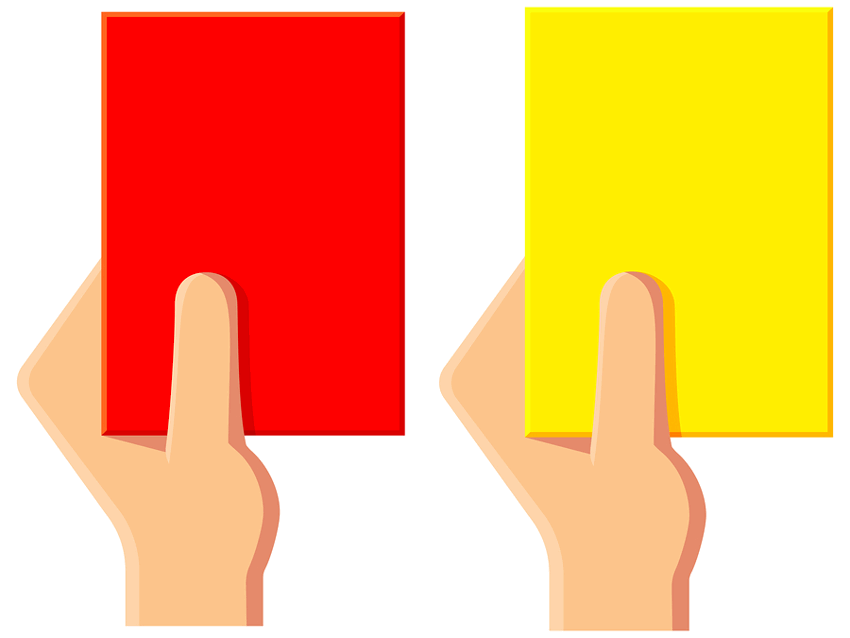
As with any article looking at the introduction of something, it’s important to take a moment to appreciate what used to happen before. If you don’t do that, of course, you’ll have no idea why things were so different once the new system came into play. For football the various rules and how they developed has long been a complex issue. In part that’s because different parts of England played the game to their own rules until they were standardised in 1877. The referee as a controlling influence on the game didn’t become an active participant in football matches until four years later.
That’s not to suggest that there was no discipline to the game before 1881, of course. Yet there wasn’t an external factor to it until then, with previous monitoring of the rules falling on the captains of each team playing in a match. The first time any sort of punishment for breaking a rule came about in 1872 when an indirect free-kick was given for handball. Even then that was mainly because the game was still transitioning from the sport that we think of today as rugby into the one we know better as football. It was used to help players realise only the goalkeeper could handle the ball, rather than to punish them for deliberately breaking rules to gain their team an advantage.
Sometimes captains would disagree, especially as the competitive side of the game developed. That was why ‘umpires’ were introduced in 1874, having the job of mediating between the captains to decide upon the correct outcome of an incident. That was the same year when free-kicks were extended to cover foul play and offside, not just handballs. When referees were first introduced in 1881 they were initially there to settle disputes between the umpires who represented each team. It’s interesting to note that that was also the same year that a caution could be issued for ‘ungentlemanly behaviour’, whilst a sending off could be given if a player committed ‘violent conduct’.
Why Were Red and Yellow Cards Needed in Football
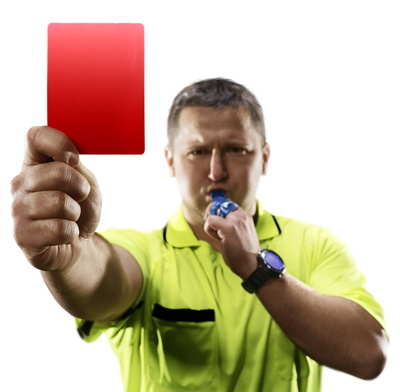 If cautions could be issued to players as early as 1881, then why was it felt that there was a need to introduced a visual representation of that fact? As is so often the case with spectator sports, the answer was about communication. During the 1962 World Cup, an Englishman named Ken Aston refereed the tournament’s opening game between Switzerland and the host nation, Chile. He did such a good job that FIFA asked him to also officiate a game between Chile and Italy, which everyone knew was likely to be a fiery affair. Indeed they were right, with armed place needing to aid Aston in his refereeing of the game on three separate occasions, leading to him saying years later, “I wasn’t reffing a football match, I was acting as an umpire in military manoeuvres”.
If cautions could be issued to players as early as 1881, then why was it felt that there was a need to introduced a visual representation of that fact? As is so often the case with spectator sports, the answer was about communication. During the 1962 World Cup, an Englishman named Ken Aston refereed the tournament’s opening game between Switzerland and the host nation, Chile. He did such a good job that FIFA asked him to also officiate a game between Chile and Italy, which everyone knew was likely to be a fiery affair. Indeed they were right, with armed place needing to aid Aston in his refereeing of the game on three separate occasions, leading to him saying years later, “I wasn’t reffing a football match, I was acting as an umpire in military manoeuvres”.
During that match he dismissed the Italian played Giorgio Ferrini, yet because of the language barrier the player didn’t understand what he was being told and refused to leave the field of play. That incident stuck with Aston, even after he retired in 1963. He was asked to join FIFA’s Referees’ Committee, leading to him being in charge of the referees for the 1966 World Cup. During a match between Argentina and England in that competition he needed to calm down Argentina’s captain, Rattín, after he’d been sent off. Yet it was the report in the newspapers the following day that made him recall the communication issues he’d suffered four years earlier. Papers claimed that the match referee had cautioned both Bobby and Jack Charlton, though the referee hadn’t indicated doing so publicly. It led to Alf Ramsey approaching FIFA for clarification on the issue and led Aston to think about how things could be made clearer to all concerned.
It was whilst driving down a road in London that the Englishman had his epiphany. He later said, “As I drove down Kensington High Street, the traffic light turned red. I thought, ‘Yellow, take it easy; red, stop, you’re off’”. Aston was a teacher before he became a referee, so knew only too well about the importance of communicating to those that you’re trying to control. He approached FIFA with his idea and yellow and red cards a decision was taken to trial the use of them at the World Cup in Mexico in 1970. Though they were deemed to be a success during the tournament, they weren’t initially adopted officially into the Rules of the Game and were rolled out somewhat gradually to European leagues in the following seasons. They didn’t make it to English shores until 1976 and weren’t initially all that popular…
Introduction, Removal & Re-Introduction Of Cards
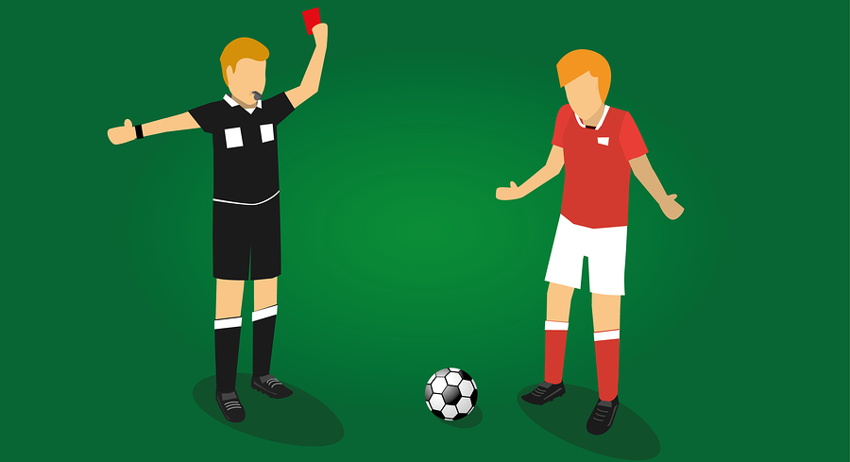
Yellow and red cards were introduced to the English league in 1976, with two red cards shown on the first day of their use. There was initially a bit of confusion over what they were supposed to be given for, with Blackburn Rovers’s David Wagstaffe becoming the first player to be show a red card when he argued with the referee after thirty-six minutes of the match. Sixty-seven minutes into his match for Manchester United that same afternoon, George Best was shown a red card for swearing.
Part of the problem was that referees began to become more and more demonstrative in the way that they officiated games. As violence on the terraces began to become more regular in the 1970s and early 1980s it was felt that the more ‘show off’ nature of some referees was adding to the issue. In 1981, therefore, the FA Council decided to get rid of red cards in the hope that it would calm down the reaction of the supporters in the stands if they had less visual impetus to get upset about. That didn’t work, of course, and by 1987 the decision was taken out of the Football Association’s hands. The International Football Association Board, which is in charge of the introduction of rules across the sport of football, decided that England was out of step with the rest of the world and needed to re-introduce cards ahead of the 1987-1988 season, which they did.
After their re-introduction to the game, a Luton player named Mick Harford became the first person to be shown a red card during his club’s match with Derby County on the 15th of August 1987. According to the English National Football Archive, around ten-thousand red cards have been shown in domestic English games and European matches involving English teams since then. The use of the cards has made it clearer to players, managers and supporters whether or not a player has been sent off, though we all still debate whether or not they should have been practically every single time. Colour-coding things can offer clarity about whether or not a decision has been made, though not about why it has!
Famous Red Cards

The reasons that a player has been sent off have been numerous and varied since the carding system was first introduced, with some standout examples being available on the issue.
Here are some of the best:
Zinedine Zidane – France v Italy – World Cup 2006

Seven minutes in to the World Cup final in 2006 and Marco Materazzi fouled to give away a penalty, which was cooly converted by the France captain, Zinedine Zidane. Twelve minutes later and Materazzi atoned for his error by getting on to the end of an Andrea Pirlo corner to equalise with a header. Despite chances for both teams, that’s how normal time ended and the game went to extra-time. Zidane nearly scored a winner with his head, only for Italy’s goalkeeper Gianluigi Buffon to save it brilliantly.
With ten minutes left of extra-time and penalties looming, Zidane and Materazzi were jogging towards the halfway-line when they were seen exchanging words. The Italian tugged at the Frenchman’s shirt but Zidane walked away. Suddenly he stopped, turning around head-butting the Italian in his chest, with Materazzi falling to the ground. The referee actually missed the incident, but was told about it by his fourth official and promptly issued Zidane with a red card. Materazzi confirmed years later that he’d provoked Zidane by responding to the Frenchman saying ‘if you want my shirt you can have it after’ by saying, “I prefer the whore that is your sister”. The game petered out to a penalty shout-out, which Italy won 5-3.
Dyer and Bowyer – Newcastle v Aston Villa – Premiership 2005
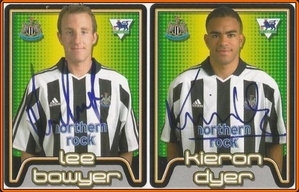 This is perhaps an example of a red card offence that best summarises what was meant all those years ago by ‘ungentlemanly behaviour’. It’s one thing to come to blows with a player on the opposite team to yours, but quite another to lose your rag with your own teammate! Yet that’s exactly what happened during a match in the Premiership, later rebranded as the Premier League, back in 2005. Aston Villa were visiting Newcastle at St. James’ Park and were 3-0 up, causing a decent amount of angst for the home supporters.
This is perhaps an example of a red card offence that best summarises what was meant all those years ago by ‘ungentlemanly behaviour’. It’s one thing to come to blows with a player on the opposite team to yours, but quite another to lose your rag with your own teammate! Yet that’s exactly what happened during a match in the Premiership, later rebranded as the Premier League, back in 2005. Aston Villa were visiting Newcastle at St. James’ Park and were 3-0 up, causing a decent amount of angst for the home supporters.
That angst was only increased during the second-half when Lee Bowyer marched towards his own teammate, Kieron Dyer, and began to punch him repeatedly. He hit him four times before Dyer responded in kind, only for both players to be shown a red card by the match referee. Dyer later said, “I didn’t realise that you could get sent off for fighting your team-mate. The referee came over and showed me the red card. Then he sent Bow off, too”.
David Beckham – England v Argentina – World Cup 1998
 Back to the World Cup now, and this time a last sixteen match between England and Argentina at the tournament in France in 1998. There has always been something of a rivalry between the two nations, with a mention of the Falkland Islands never far away when they play each other. This match was delicately poised at 2-2 when David Beckham, affectionately known as ‘Golden Balls’ by the English press, was fouled by Diego Simeone. As the Argentine was walking away from the incident, Beckham flicked out his right leg and tripped him up.
Back to the World Cup now, and this time a last sixteen match between England and Argentina at the tournament in France in 1998. There has always been something of a rivalry between the two nations, with a mention of the Falkland Islands never far away when they play each other. This match was delicately poised at 2-2 when David Beckham, affectionately known as ‘Golden Balls’ by the English press, was fouled by Diego Simeone. As the Argentine was walking away from the incident, Beckham flicked out his right leg and tripped him up.
The incident occurred right in front of the match referee, who correctly gave Beckham his marching orders. Though England were able to hold on for a 2-2 draw, they then lost on penalties – something that will surprise precisely nobody that has watched England in knockout football over the years. Simeone later confessed that he ‘took advantage’ of the situation to get the England player sent off, whilst David Beckham bizarrely referred to the incident as one of his ‘top five career moments’. Presumably he meant moments he learnt from, as opposed to moments to be proud of…
Luis Suarez – Uruguay v Ghana – World Cup 2010

When Uruguay faced Ghana in the quarter-final of the World Cup in 2010, they weren’t just top against a team. The tournament was being held in South Africa and it seemed, for a moment, as though there would be an African team in the semi-finals of the tournament. Ghana had taken the lead on the stroke of half-time when Sulley Muntari struck scored from thirty-five yards. Ten minutes into the second-half and Diego Forlán equalised with a free-kick, with no further goals being scored and the game ending up going to extra-time.
There were relatively few chances in a closely competed second-half, but massive drama ensured in stoppage-time during the second-half of extra-time. The African player Appiah had a shot cleared off the line by Luis Suarez’s knee, only for the ball to fall to Adiyiah who headed it towards the goal. Suarez stuck out his arm and blocked it with his hands, being sent off as a result. It was worth it for Uruguay, however, when Asamoah Gyan missed the resulting penalty and the match ended up going to a penalty shoot-out that the South American’s won. After the match their manager, Oscar Tabarez, said that Suarez’s reaction was ‘instinctive’. He might have had a point – if you watch a video of the incident you’ll notice that it wasn’t just Suarez trying to block the header with his hands…
Eric Cantona – Crystal Palace v Manchester United – Premiership 1995

It would be wrong to discuss red card incidents without mentioning this. Though the actual red card wasn’t issued for the event the match is most remembered for, it most certainly would’ve been if the referee hadn’t already shown it. The incident occurred on the twenty-fifth of January 1995, two days after Eric Cantona had scored the winner in Manchester United’s game against league leaders Blackburn Rovers to put the Red Devils within two points of Kenny Dalglish’s side. A win over Crystal Palace at their place would put United on top of the league, but Cantona was subjected to a number of hefty challenges from Crystal Palace players – especially their centre-back Richard Shaw.
Forty-eight minutes into the match, the pair were chasing a long-ball up the field from United’s goalkeeper Peter Schmeichel when Shaw made contact with the Frenchman. As retaliation, he kicked out at him rather petulantly and the match referee, Alan Wilkie, showed Cantona a red card. As he was walking along the side of the pitch, accompanied by Manchester United’s kit man, Norman Davies, the United player suddenly stopped and turned towards the Crystal Palace supporters. He then jumped and did a kung-fu kick into a Palace fan named Matthew Simmons. United’s head of security, Ned Kelly, believed that Simmons had called Cantona’s mother a ‘French whore’, which prompted the reaction. The Frenchman has never given an explanation. United drew the match 1-1, Cantona was subsequently banned for nine months and had to serve 120 hours of community service. Blackburn went on to win the title by a point.
The Future: Sin Bins?
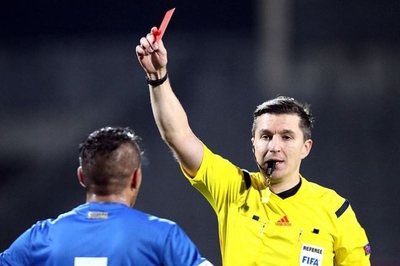
’If it ain’t broke, don’t fix it’ is a phrase that springs to mind when discussing the future of yellow and red cards. Though, of course, some people would argue that it is indeed broken. There are some offences committed on a football pitch that aren’t quite a red card but are perhaps more serious than just being a yellow. Unfortunately referees are left with little leeway as things currently stand, but might there be something in the pipeline to change all of that? In May 2017 the Football Association confirmed that it was going to trial the use of ‘sin bins’ in the lower leagues for the 2018-2019 season.
The official name that will be given to the new disciplinary procedure is ‘temporary dismissals’, with players leaving the pitch for ten minutes if they’re found to be guilty of dissent towards the referee. Initially it will only be trialled at Step Seven of the English league pyramid, with Sunday League and both men and women’s youth football also being asked to trial it. The aim is to reduce the amount of abuse that referees in the lower levels of English football are on the receiving end of, with players aware that they could be asked to leave the pitch to ‘cool down’ for ten minutes if referees feel that they’re getting too rambunctious.
Though the scheme will only be used in lower leagues initially, it opens up the possibility of some further options for referees at the top level if it’s found to be a system that works. Although the ‘sin bin’ will only be for dissent offences to begin with, if it’s successful during its trial phase then you can well imagine referees pushing to be allowed to use it for those ‘halfway house’ offences that they feel yellow cards aren’t enough for and red cards are too harsh over. As football fans will have noted with the proposed introduction of the Video Assistant Referee, the game is slow to adapt to changes. This one, however, might just be something that supporters of the sport may be able to get behind.
